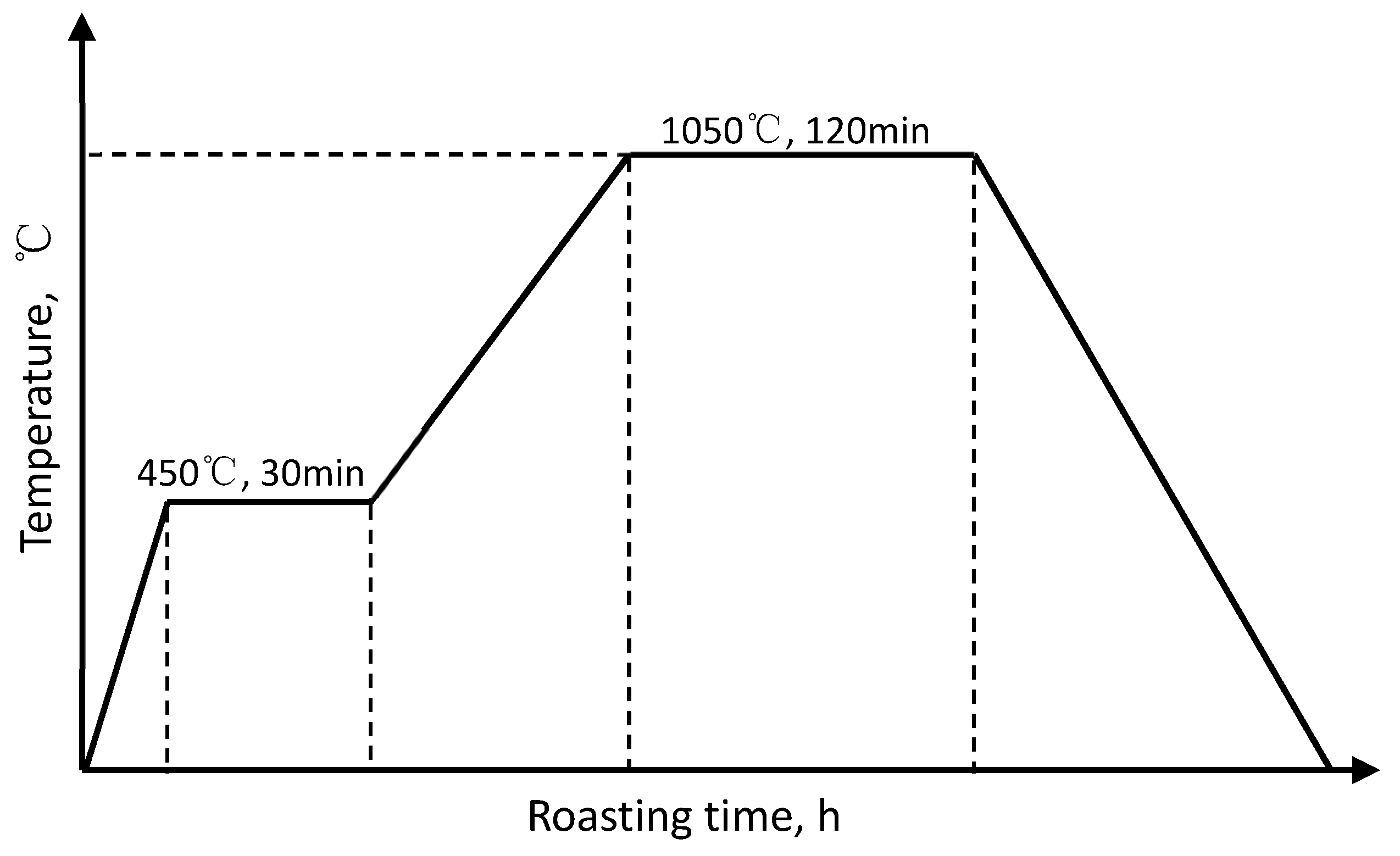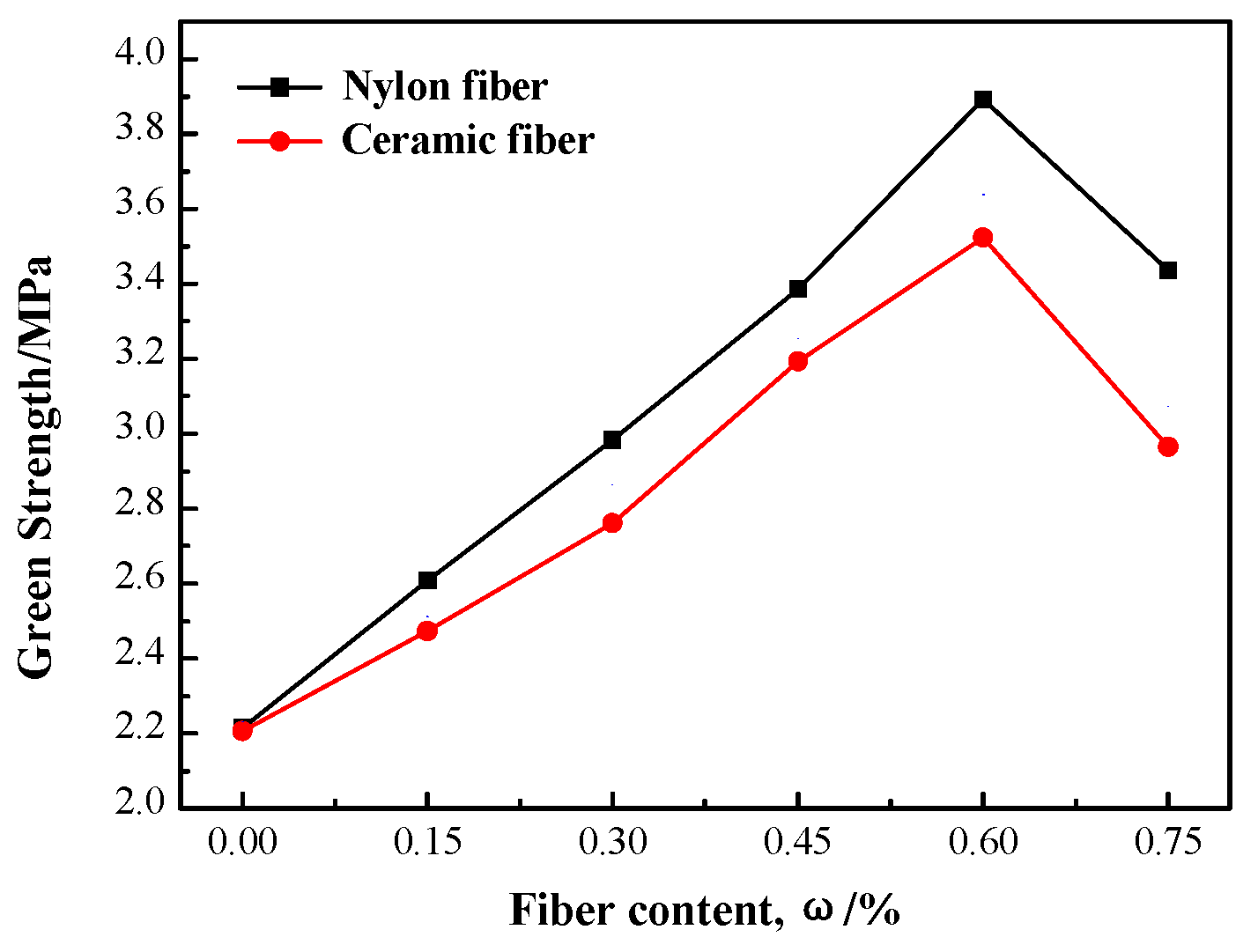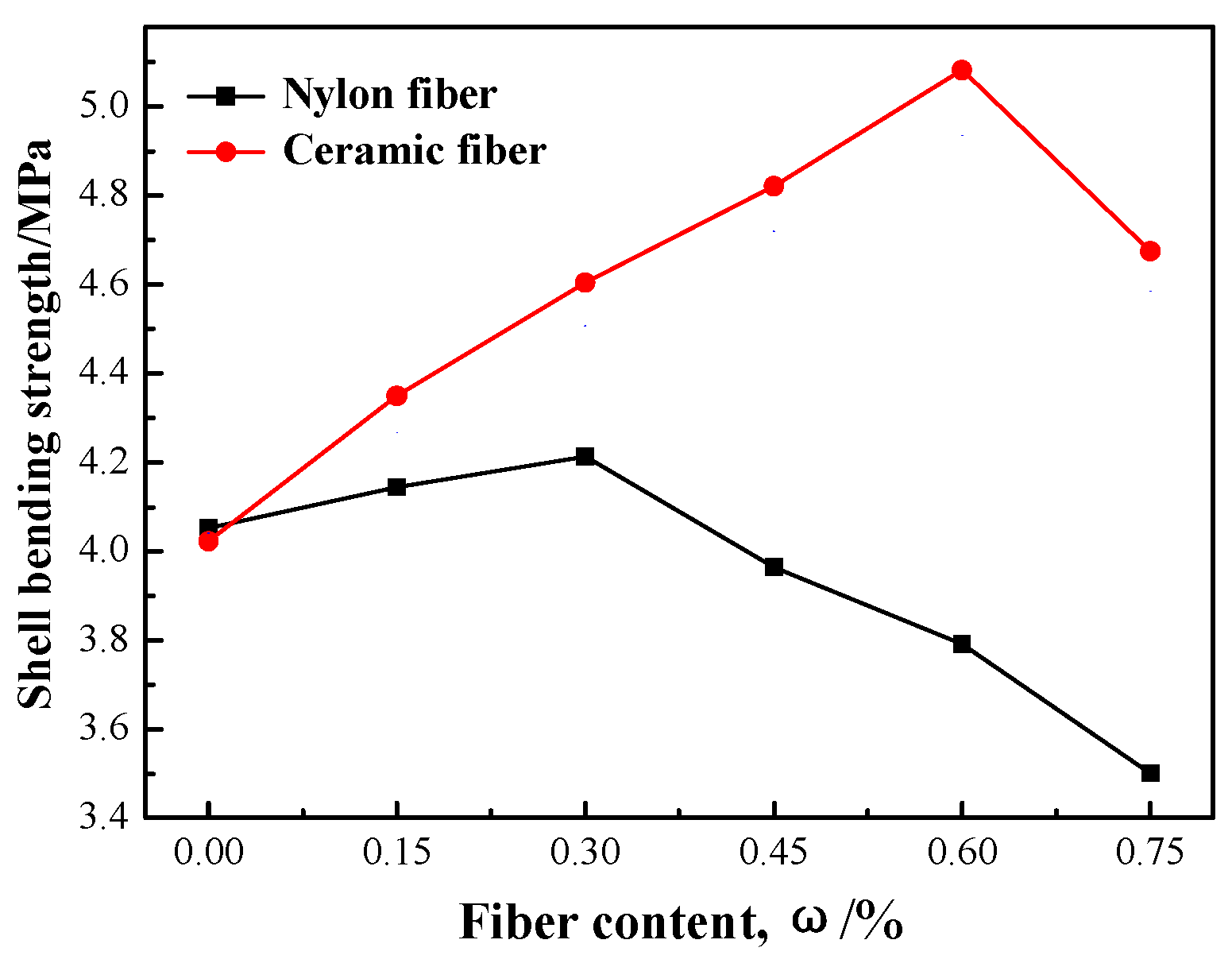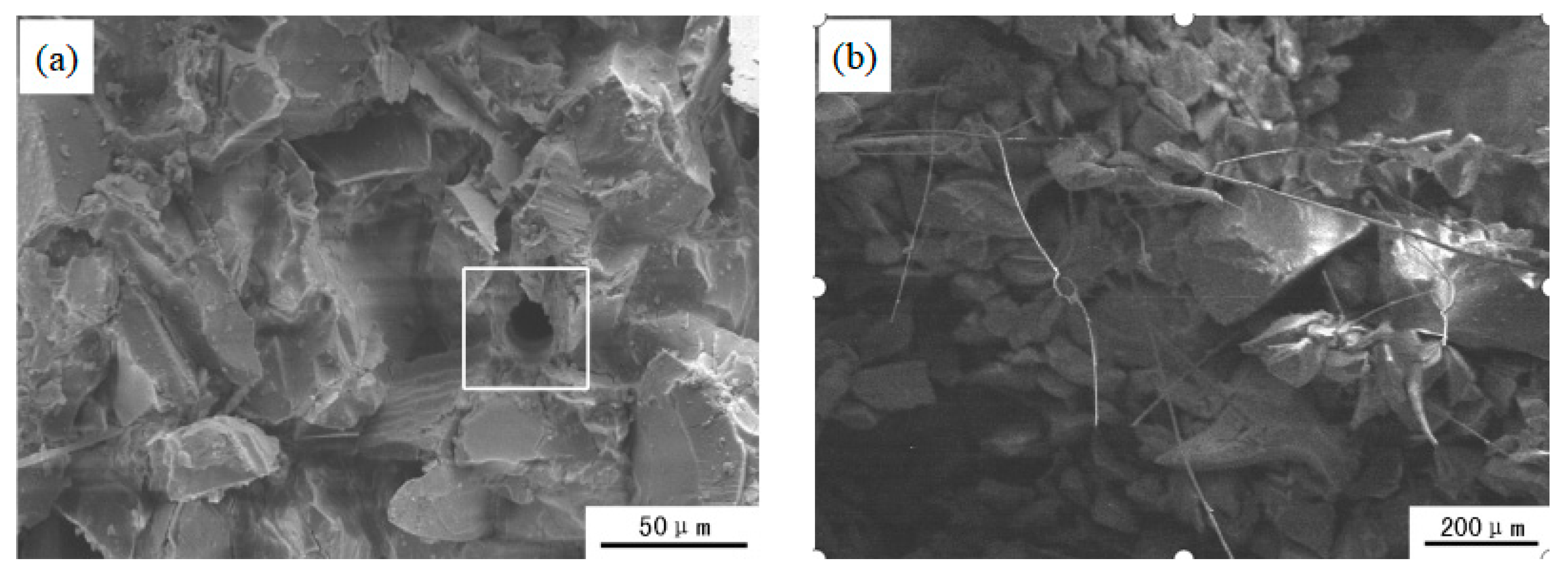Effect of Ceramic and Nylon Fiber Content on Composite Silica Sol Slurry Properties and Bending Strength of Investment Casting Shell
Abstract
:1. Introduction
2. Materials and Methods
3. Results and Discussion
3.1. Effect of Fiber Content on Movement Viscosity of Silica Sol Slurry
3.2. Effect of Fiber Content on Green Bending Strength of Investment Casting Shell
3.3. Effect of Fiber Content on High Strength of Investment Casting Shell
3.4. Distribution Morphology of Fiber Inside Investment Casting Shell
4. Conclusions
- (1)
- The movement viscosity of silica sol slurries were all enhanced with an increase in ceramic and nylon fiber content; the movement viscosity of the ceramic fiber slurry was bigger than nylon fiber slurry, and the movement viscosity of the nylon fiber slurry was close to being a linear one;
- (2)
- The green and high strength of shell first increases, then decreases with the increases of fiber content. When the fiber content increased from 0% to 0.75%, when the fiber content was 0.6%, shell green bending strength reached maximum in both; the green strength of ceramic and nylon additions achieve 3.84 MPa and 3.56 MPa, respectively. The high strength of ceramic addition achieved its biggest at 5.08 MPa, higher than without the fiber. The high strength of nylon was biggest when fiber content is 0.3%;
- (3)
- The nylon fiber distribution was relatively uniform in shell matrix; the exposed nylon fiber of outside shell was straight, with no apparently broken trails. The poor compatibility of ceramic fiber caused the weak dispersion of the ceramic fiber in the matrix, and left holes as the part of fiber bundle was uprooted.
Author Contributions
Funding
Acknowledgments
Conflicts of Interest
References
- Sanjay, K.; Karunakar, D.B. Enhancing the permeability and properties of ceramic shell in investment casting process using ABS powder and needle coke. Int. J. Metalcast. 2019, 13, 588–596. [Google Scholar]
- Dong, Y.W.; Li, X.L.; Zhao, Q.; Yang, J.; Dao, M. Modeling of shrinkage during investment casting of thin-walled hollow turbine blades. J. Mater. Process. Technol. 2017, 244, 190–203. [Google Scholar] [CrossRef]
- Pattnaik, S.; Karunakar, D.B.; Jha, P.K. Developments in investment casting process—A review. J. Mater. Process. Technol. 2012, 212, 2332–2348. [Google Scholar] [CrossRef]
- Kang, M.D.; Wang, J.; Gao, H.Y.; Han, Y.F.; Wang, G.X.; He, S.X. Effect of Solidification Behavior on Microstructures and Mechanical Properties of Ni-Cr-Fe Superalloy Investment Casting. Materials 2017, 10, 250. [Google Scholar] [CrossRef] [PubMed]
- Sunpreet, S.; Chander, P.; Parvesh, A.; Rupinder, S.; Grzegorz, K.; Catalin, I.P. Dimensionless Analysis for Investigating the Quality Characteristics of Aluminium Matrix Composites Prepared through Fused Deposition Modelling Assisted Investment Casting. Materials 2019, 12, 1907. [Google Scholar] [Green Version]
- Lu, K.; Liu, X.D.; Duan, Z.H. Effect of firing temperature and time on hybrid fiber-reinforced shell for investment casting. Int. J. Met. 2019, 13, 666–673. [Google Scholar]
- Hassan, J.; Mohd, H.I.; Ali, O. An alternative approach in ceramic shell investment casting of AZ91D magnesium alloy: In situ melting technique. J. Mater. Process. Technol. 2014, 214, 988–997. [Google Scholar]
- Zhao, E.T.; Kong, F.T.; Chen, Y.Y. Interfacial reactions between Ti-1100 alloy and ceramic mould during investment casting. Trans. Nonferrous Met. Soc. China 2011, 21, 348–352. [Google Scholar] [CrossRef]
- Hamilton, R.W.; See, D.; Burtler, S. Multiscale modeling for the prediction of casting defects in investment cast aluminum alloys. Mater. Sci. Eng. 2003, 343, 290–300. [Google Scholar] [CrossRef]
- Li, Z.L.; Xiong, J.C.; Xu, Q.Y. Deformation and recrystallization of single crystal nickel-based super alloys during investment casting. J. Mater. Process. Technol. 2015, 217, 1–12. [Google Scholar] [CrossRef]
- Barbosa, J.; Puga, H. Ultrasonic melt processing in the low pressure investment casting of Al alloys. J. Mater. Process. Technol. 2017, 244, 150–156. [Google Scholar] [CrossRef]
- Wang, F.; Li, F.; He, B.; Wang, D.; Sun, B. Gel-casting of fused silica based core packing for investment casting using silica sol as a binder. J. Eur. Ceram. Soc. 2013, 33, 2745–2749. [Google Scholar] [CrossRef]
- Omar, M.F.M.; Sharif, S.; Ibrahim, M.; Fadzil, A.S.A.; Mohd, A.A. Differential ceramic shell thickness evaluation for direct rapid investment casting. Appl. Mech. Mater. 2014, 315, 418–422. [Google Scholar] [CrossRef]
- Lu, G.; Mao, P.; Yan, Q.S.; Ji, C.Z.; Rao, W.J. Effect of Composite Fiber Content on Strength and Gas Permeability of Precision Cast Silica Sol Shell. Chin. J. Nonferrous Met. 2015, 15, 3164–3170. [Google Scholar]
- Chen, B. Polymer and Fiber Reinforced Silica Sol—Review of Progress in Foreign Precision Casting Technology. Spec. Cast. Nonferrous Alloy 2005, 25, 231–233. [Google Scholar]
- Lu, G.; Mao, P.; Yan, Q.S.; Wu, H.; Ji, C.Z. Effect of ultrasonic vibration and hydroxypropyl methylcellulose on the dispersion properties of chopped fibers in precision cast silica sol slurry. J. Mater. Eng. 2016, 44, 71–76. [Google Scholar]
- Tuan, K.T.; Dong, J.K. High strain rate effects on dire ct tensile behavior of high performance fiber reinforced cementitious composites. Cem. Concr. Comp. 2014, 45, 186–200. [Google Scholar]
- Estabragh, A.R.; Bordbar, A.T.; Javadi, A.A. Mechanical behavior of a clay soil reinforced with nylon fiber. Geotech. Geol. Eng. 2011, 29, 899–908. [Google Scholar] [CrossRef]
- Abraham, T.N.; George, K.E. Short nylon fiber reinforced PP: Melt rheology. Poly. Plast. Technol. Eng. 2007, 46, 321–325. [Google Scholar] [CrossRef]
- Tian, J.; Shi, Z.Q.; Zhong, S.Y.; Liao, Z.L. Microstructural evolution and deformation mechanism during creep of Al2O3-SiO2(sf)/AZ91D composite. Chin. J. Nonferrous Met. 2013, 23, 1241–1247. [Google Scholar]
- Liu, G.J.; Li, W.F.; Ma, L.J.; Peng, J.H. Interfacial microstructure and mechanical properties of AZ91D composites reinforced by aluminum silicate short fibers. Acta Mater. Comp. Sin. 2008, 25, 156–159. [Google Scholar]
- Wang, J.L.; Lin, W.S.; Jiang, Z.W.; Yang, G.L.; Duan, L.H. Preparation and Microstructure of Fiber Structure Molybdenum-Copper Composites. Chin. J. Nonferrous Met. 2014, 24, 174–178. [Google Scholar]
- Jones, S.; Yuan, C. Advances in shell moulding for investment casting. J. Mater. Process. Technol. 2003, 135, 258–265. [Google Scholar] [CrossRef]
- Yuan, C.; Jones, S. Investigation of fiber modified ceramic moulds for investment casting. J. Eur. Ceram. Soc. 2003, 23, 399–407. [Google Scholar] [CrossRef]
- Nadolski, M.J.; Konopka, Z. The investigation of properties of investment casting moulds reinforced with ceramic fiber. Arch. Foundry Eng. 2007, 7, 127–130. [Google Scholar]
- Maity, P.C.; Maity, J. Development of high strength ceramic shell for investment casting. Indian Foundry J. 2001, 47, 23–26. [Google Scholar]
- Lu, D.H.; Wang, Z.; Jiang, Y.H.; Zhou, R. Effect of aluminum silicate fiber modification on crack-resistance of a ceramic mould. China Foundry 2012, 9, 322–327. [Google Scholar]
- Zawati, H.; Noor, H.K.; Muhamad, Z.Y. Permeable rice husk fiber shell mould system. Adv. Mater. Des. Mech. 2013, 372, 331–335. [Google Scholar]
- Yuan, C.; Jones, S.; Blackburn, S. The influence of autoclave steam on polymer and organic fiber modified ceramic shells. J. Eur. Ceram. Soc. 2005, 25, 1081–1087. [Google Scholar] [CrossRef]
- Wang, H.; Liu, X.D.; Lü, K.; Feng, H.; Li, Y. Strength of short glass fiber-reinforced silicon sol shell for investment casting process. Spec. Cast. Nonferrous Alloy 2014, 34, 633–636. [Google Scholar]
- Liu, Q.B.; Leu, M.C.; Richards, V.L. Fracture toughness of ceramic moulds for investment casting with ice patterns. Int. J. Cast. Met. Res. 2007, 20, 14–24. [Google Scholar] [CrossRef]
- Alkoy, S.; Yanik, H. Fabrication of lead zirconate titanate ceramic fibers by gelation of sodium alginate. Ceram. Int. 2007, 33, 389–394. [Google Scholar] [CrossRef]
- Wei, C.C.; Chen, O.Y.; Liu, Y.; Li, K. Ceramic asymmetric hollow fibre membranes—One step fabrication process. J. Membr. Sci. 2002, 320, 191–197. [Google Scholar] [CrossRef]
- Zeng, L.K.; Hu, D.L. The study on the dispersive property of ceramic fiber and fiber glomeration. J. Ceram. 2008, 29, 324–328. [Google Scholar]








| Fibers Type | Length/mm | Diameter/μm | Tensile Strength/GPa | Elastic Coefficient/GPa | Density/(g. cm−3) | Melting Point/°C |
|---|---|---|---|---|---|---|
| Ceramic fiber | 4~7 | 4~8 | 4 | 290 | 1.85 | 1800 |
| Nylon fiber | 4 | 9~13 | 0.9 | 5.17 | 1.16 | 224 |
| Coating Layer | Refractory Powder (Mesh) | Sanding Materials (Mesh) | Drying Time at Room Temperature (h) |
|---|---|---|---|
| Primary layer (1) | White corundum powder (320) | White corundum sand (100) | 8 |
| Transition layer (2) | White corundum powder (320) | Mullite sand (60) | 12 |
| Backup layer (3–5) | White corundum powder (320/100) | Mullite sand (46/20) | 12 |
| seal layer (6) | White corundum powder (320/100) | — | 24 |
© 2019 by the authors. Licensee MDPI, Basel, Switzerland. This article is an open access article distributed under the terms and conditions of the Creative Commons Attribution (CC BY) license (http://creativecommons.org/licenses/by/4.0/).
Share and Cite
Huang, P.; Lu, G.; Yan, Q.; Mao, P. Effect of Ceramic and Nylon Fiber Content on Composite Silica Sol Slurry Properties and Bending Strength of Investment Casting Shell. Materials 2019, 12, 2788. https://doi.org/10.3390/ma12172788
Huang P, Lu G, Yan Q, Mao P. Effect of Ceramic and Nylon Fiber Content on Composite Silica Sol Slurry Properties and Bending Strength of Investment Casting Shell. Materials. 2019; 12(17):2788. https://doi.org/10.3390/ma12172788
Chicago/Turabian StyleHuang, Pengpeng, Gang Lu, Qingsong Yan, and Pu Mao. 2019. "Effect of Ceramic and Nylon Fiber Content on Composite Silica Sol Slurry Properties and Bending Strength of Investment Casting Shell" Materials 12, no. 17: 2788. https://doi.org/10.3390/ma12172788





